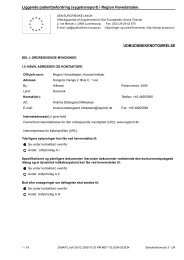Territorial Review Copenhagen - Region Hovedstaden
Territorial Review Copenhagen - Region Hovedstaden
Territorial Review Copenhagen - Region Hovedstaden
Create successful ePaper yourself
Turn your PDF publications into a flip-book with our unique Google optimized e-Paper software.
164<br />
bridge construction but for studies to estimate the bridge‘s potential benefits.<br />
Further co-operation between both countries is desirable.<br />
Unlike the Øresund Bridge, this new bridge will not provide a better<br />
connection between urban regions like <strong>Copenhagen</strong> and Malmö, but will<br />
interlink rural areas in Denmark and Germany. Its basic function will<br />
therefore be that of a transport lane, providing a better connection between<br />
Germany, Denmark and the rest of Scandinavia. The more rural areas of<br />
Jutland will be the primary beneficiaries of a successful regional integration,<br />
as well as the regions most directly concerned: Ostholstein (Germany) and<br />
Storstrøm (Denmark). In the long run, there are wider economic effects of<br />
the Fehmarn Belt Link (see Box 2.7). Once the connection between<br />
Fehmarn Link and <strong>Copenhagen</strong> is accomplished, it will have a strong impact<br />
on regional economic structure of Denmark, through the connection with<br />
European high-speed network (TGV). Through-traffic is highly likely to<br />
increase and cause more pressure in the city centre of <strong>Copenhagen</strong>. To<br />
assure smooth transportation of goods and people, establishment of Ring 5,<br />
connecting Sjaelland and Helsingør and the physical link between Helsingør<br />
and Helsingborg, will be necessary in the long run. Connection to the<br />
northern Europe through Hamburg, Hannover and Bremen and development<br />
of the Nordic triangle among <strong>Copenhagen</strong>, Stockholm and Oslo would be<br />
facilitated, to the advantage of <strong>Copenhagen</strong>. Two important key points in the<br />
logistic sector, <strong>Copenhagen</strong> Airport and Port of <strong>Copenhagen</strong>/Malmö, still<br />
have abundant space to accommodate new companies that require vast land.<br />
Box 2.7. Estimated effects of the Fehmarn Belt Link<br />
One of the first studies, undertaken in 1999, for assessing the economic<br />
impact of a fixed Fehmarn Belt link considered three scenarios: (1) a fixed link<br />
with a four-lane highway and two railway tracks, (2) a fixed link with a two- or<br />
three-lane highway and a single-track railway line, and (3) a fixed two-track<br />
railway link with shuttle trains for cars and lorries. 1 According to the study, net<br />
employment effects of the project (without multiplier effects) are approximately<br />
1.280 (scenario 1), 1.310 (scenario 2) and 1.280 (scenario 3). Given the regional<br />
distribution of these increases in jobs, <strong>Copenhagen</strong> stands to gain the most<br />
(between 300 and 360 jobs), together with Hamburg (between 250 and 350).<br />
A study undertaken in 2004 by <strong>Copenhagen</strong> Economics and Prognos 2<br />
indicated that a new bridge will be faster and more flexible than using ferries, so<br />
transportation frequency will rise and provide incentives for commuting, more<br />
cross-border activities and perhaps migration. For companies, the bridge will<br />
provide better access to the neighboring market, and lower transportation costs<br />
will make business more profitable, increase production and benefit both sides<br />
of the bridge. According to a cost-benefit analysis, the construction and

















